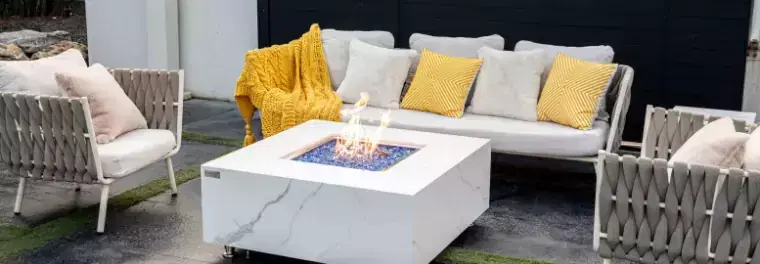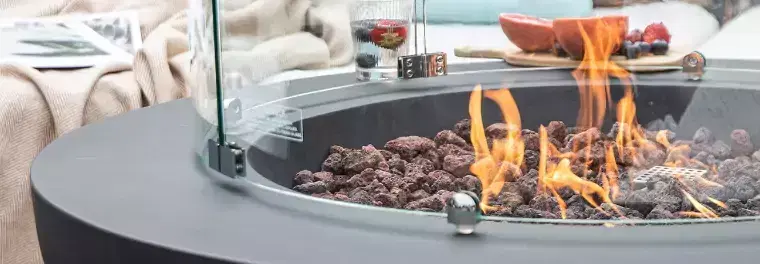Let's Make it (Email) Official
Become an AuthenTEAK Insider and be first to know about new collections, exclusive sales, and special offers.
Let's Make it (Email) Official
Become an AuthenTEAK Insider and be first to know about new collections, exclusive sales, and special offers.

A functional focal point, fire pits and enhance the usability of a backyard. Fire pits primarily come in three models: natural gas, liquid propane (LP), and wood-burning. Gas and LP fire pits offer a quick-to-ignite option, while wood-burning models provide a classic, campfire-like experience. The best choice for your yard will depend on how you plan on using your fire pit. While most outdoor fire pits are designed to be relatively user-friendly, there are some dos and don’ts to be aware of. Here are some helpful tips on how to use a fire pit—and how to choose the best model for your needs.

Gas and LP fire pits and fire tables are less labor-intensive and time-consuming to get started than wood alternatives. Wood-burning fire pits tend to produce hotter flames than their gas counterparts, making them a better fit for people looking to use their fire pit for cooking or in cooler weather. They also produce the smoky flame and atmosphere associated with camping.
No matter which model you choose, it is important to follow the appropriate safety protocol. If wood fires are more your style, be sure to keep the fire pit away from any potential hazards. If you have a gas fire pit, be sure to regularly check the propane tank for leaks. Additionally, learning how to use a fire pit that is gas-fueled requires understanding what to put in the bottom of a fire pit.

Once you have chosen the fuel type best suited to your backyard and needs, you’ll need to learn how to use a fire pit safely. You should ALWAYS read and follow the directions listed in your fire pit’s installation guide. Some general tips for using your fire pit:
Start by determining where you want to place your fire pit in your yard. Be sure to check your local fire ordinances and town codes, as different areas will have different restrictions regarding fire pit placement. In general, you’ll want to choose a flat spot in a non-combustible area that is a safe distance from any hazards.
Once you have chosen a spot, be sure to clear away any dry sticks, leaves, or flammable substances in the area surrounding your fire pit.
Measure the distance of your fire pit from your home and other flammable surfaces to ensure it complies with safety standards. While exact measurements will vary by model, in general, it is best practice to place your fire pit at least 10 feet away from your home. If you are placing your fire pit in a covered area—such as a pergola, covered patio, or veranda—you’ll also need to allow for approximately 7-10 feet of height clearance.
Once you have ensured the safety of your fire pit location, you can assemble your fire pit by following the directions provided in your owner’s manual. If you have selected a natural gas fire pit, you may want to consider consulting a professional, as these fire pits will require setting up a connection to the natural gas line in your home.
Once your fire pit is set up, it is ready for use. Operation directions will vary depending on the fuel your fire pit is powered by. Be sure to follow the instructions and safety protocol for your model.
Following these general guidelines will help you learn how to use a fire pit safely. We want to emphasize the importance of beginning the installation process by checking your area’s fire pit rules and regulations, as they can heavily influence where your fire pit can go in your yard. For example, some towns have certain restrictions for placing fire pits on decks composed of certain materials.

Choosing what to put in the bottom of a fire pit is one of the most important elements of learning how to use a fire pit safely. Contemporary fire pits are designed to use some kind of medium—such as gas logs, fire glass, lava rocks, or fire beads—to evenly distribute heat and act as a protective barrier for the burner. However, there are certain materials that should not be used as fire pit fillers.
Gravel, sand, and river rocks can trap water inside their pores. When exposed to consistent heat, the water in these rocks heats up, expands, and eventually causes the rocks to crack or explode. Therefore, it is best to avoid putting these materials at the bottom of your fire pit.
The best choice for fire pit fillers is gas logs, cannon fireballs, lava rocks or fire glass. These materials have natural heat insulation and retention properties, making them great filler materials. Some of the benefits of lava rock and fire glass include:
They create a protective barrier for the burner. A 3-4-inch layer of lava rock or fire glass will act as a weatherproof shield for your fire pit’s burner. Since the heat of a fire pit is concentrated on its surface, the insulating properties of lava rock can also protect the burner from getting too hot.
They allow for even heat distribution. Lava rocks evenly distribute and retain heat, providing even, sustained warmth to all areas of a fire pit.
They are low-maintenance and durable. When exposed to high heat and harsh weather conditions, lava rocks and fire glass retain their natural color and quality. Additionally, they are low-maintenance and easy to clean.

Ensure your lava rocks or fire glass are completely dry before starting a fire. Although these materials are the superior choice for fire pit fillers, they still have the potential to explode if they are heated while damp or wet.
After learning how to use a fire pit safely, you can properly choose the best rocks or fire glass for your firepit. For additional maintenance protocols, design tips, and grilling recipes, subscribe to our email list or follow us on Instagram. Create the perfect setup with the best fire pit chairs.
Categories
Recent Posts